What Is A Tippet In Fly Fishing?
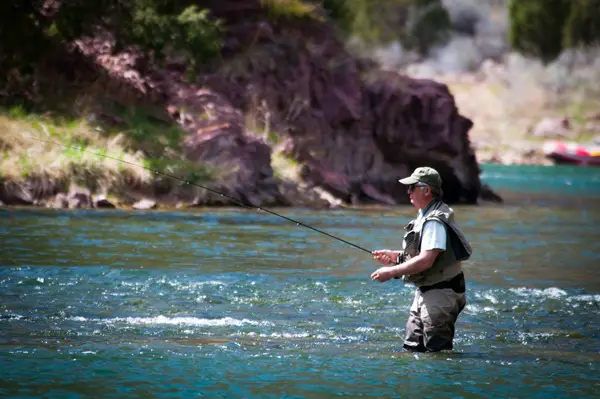
A tippet in fly fishing is the fishing line that is tied to a fly. The other end of the tippet is tied to the leader.
A fly line will be set up like this on the fly reel: backing material > fly line > leader > tippet > fly.
The tippet material should less breaking strain poundage then the leader.
Normally the tippet will be a smaller, fine diameter so the fish won’t see it, or it doesn’t interfere with the flies’ movement on or in the water.
A tippet is like a leader, but instead of constantly cutting your leader to tie a fly on, you use the tippet instead to tie the fly on. (Which you don’t have to cut as much as it is tied one end to the fly line.)
For fishing were big species of fish are found, you would use a heavier poundage tippet.
For fishing small streams or chasing small pan fish, a light poundage, small diameter tippet would be used.
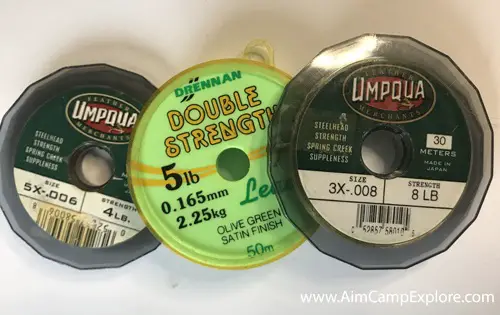
You can get tippet material in a few types of fishing line material. Like fluro carbon and monofilament fishing line.
Mono (monofilament) which is basically normal fishing line has been used for tippets and leaders for decades. But now there are other alternatives which are great for tippets as they can be a slightly thinner diameter, for the same breaking strain. (The quality does vary from manufacturer.)
Fluro carbon fishing line for tippet material is popular as it can be harder for the fish to see it tied to the artificial fly.
Do you need a tippet for fly fishing?
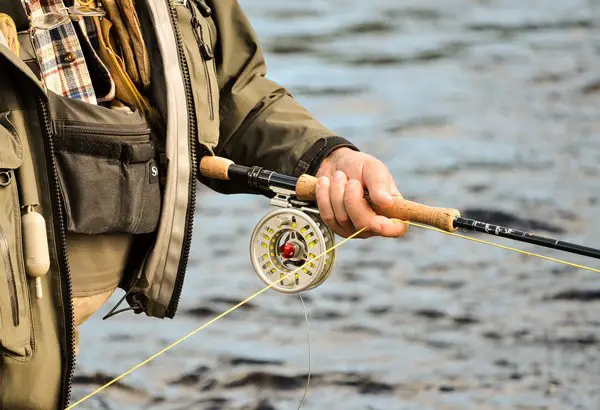
There are several advantages in having a tippet. One is it saves cutting and using your leader if you tie a fly directly to the leader.
Having a tippet lets you change tippet strength / diameter for different fishing conditions and fish. Such as for Brook trout you have a thinner diameter tippet. Chasing big bass in timber areas, you need a heavier poundage tippet because you might get snagged.
If you do get a snag, or a fish breaks you off, the tippet is the lightest breaking strain of your fly fishing backing, fly line and leader. This means you don’t lose all your gear, only the tippet and fly, which is easier to replace then the leader, or expensive fly line.
What is the X on tippet?
Tippet material and leaders are also labeled with number system by manufacturers as well as the poundage. This can be referred to the “X” system.
This “X” number is designed to help with diameter sizes for fishing line.
The smaller the diameter the larger the number and breaking strain poundage. Such as 0X is roughly 15.5 pounds, 8X about 1.75 pounds.
Here is a simple list of the X system sizes:
0X is around 15.5 pounds.
1X 13.5 pounds.
2X 11.5 pound test.
3X 8.5 pounds.
4X will be about 6 pound test.
6X is about 3.5 pounds.
7X 2.5 pounds.
8X around 1.75 pounds.
The poundage can very a little bit for diameter size between manufactures, as not all fishing line manufactures have the same quality or standards. Also different fishing line material can make a difference, such as mono versus fluorocarbon in thickness and strength.
How long should the tippet be?
A general guide is it might be around 3 feet long or a bit longer.
This will depend on the type of fishing you are doing, conditions and the fish species targeted. Such as if you are nymphing in clear waters for spooky trout you might have a 6 foot tippet.
For fly fishing at night time in windy areas, with lots of snags, your tippet might only be 2 to 3 feet long, to control it better with larger wet flies.
A long tippet (and leader) is harder to cast and present the fly nicely. A very short tippet and you might scare the fish off in clear waters as it is closer to the thicker fly line.
Overall a leader might be 7 foot to 9 foot long and the tippet section around 3 feet long or more. Giving the total leader and tippet length 10 to 12 feet. But again will depend on conditions, fish type and characteristics, etc.
The angler’s skill in casting also comes into play when tippet length is considered.
A shorter leader and tippet will be easier to cast for a beginner when learning how to fly fish.
What are tippet rings used for?
You can get tiny little, “micro tippet rings” that you tie on the end of the leader. The tippet is then tied to the tippet ring as well.
This saves you from cutting into the leader, every time you change the tippet. (Also from learning 101 different knots, on connecting line to line.)
These tippet rings are fiddly, but are great to use and I love using them on my fly fishing gear.
One negative thing is that they are very small and easy to lose bank side when tying one on. You have to have a lot of patience with these, but they are ingenious simple little devices.
What tippet poundage should I use to fly fish for trout?
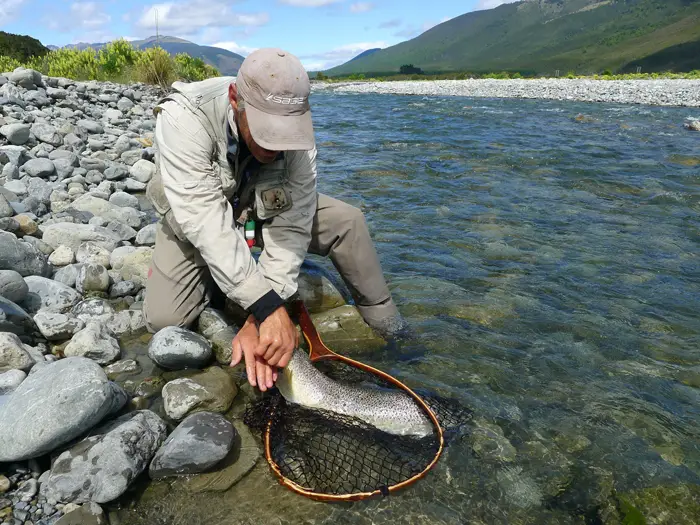
Depending on the trout species around and size, you might fish with a 5 – 6 pound tippet. The tippet poundage should also take into account the angler’s skill and weather conditions. Also what the fish are feeding on, or what is available.
Such as if the trout might be feeding on midges, in clear calm waters, you might choose a long 3 to 4 pound tippet or lower strength to get a finer diameter, so you don’t spook the trout.
If it is windy, you don’t want wind knots and the fly blown everywhere, so a 6 pound shorter tippet might work.
Fishing at night time for big trophy trout in timber areas, where you can easily get snagged, you might use an 8 pound tippet or stronger.
“Fly size also can also dictate what tippet size and poundage to use on trout.”
A large fly on a very thin diameter tippet will be harder to turn over and present accurately on the water. As an example, you wouldn’t want to be casting big wet flies or streamers on a 2 pound tippet.
Vice versa, an 8 pound tippet is hard to use and tie on a tiny midge pattern. You may not even thread the line through the eyelet of the hook as it would line probably would be too large.
For more information on the types of flies, visit – Types of Fly Fishing Flies.
Have three or more spools of tippet poundage / size in you fly vest, so you can change to the feeding, weathers conditions easily.
What tippet poundage should I use to fly fish for bass?
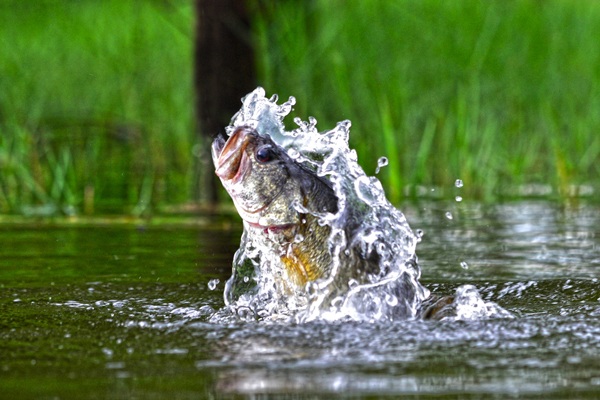
Generally you might be looking for largemouth bass and small mouth bass around roughly 8 pound to 12 pound tippet. Which is around 2X to 3X size.
Similar to trout, the tippet strength will depend on conditions and average size of the bass about. You don’t want to fish a 4 pound tippet if monster bass are about in the area.
Likewise, using a 15 pound tippet in a small pond with small bass won’t work great either.
What tippet poundage should I use to fly fish for salmon?
In both freshwater and saltwater, salmon sizes can vary widely for this game fish as you have several species, such as: Coho salmon, Atlantic salmon, Chum salmon, Chinook salmon, to name a few.
So tippet breaking strain might be from 6 pound up to 15, or even 20 pound tippet strength for fly fishing for salmon.
Overall, tippet strength will depend if you are fishing imitation fish eggs in a small stream, or casting big streamers with a Spey rod, or saltwater fly fishing and the type of salmon.
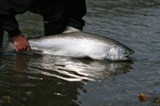
What tippet poundage should I use to fly fish for crappie?
Around 3.5 pounds 6X to about 4.75 pound 5X for fishing tippet size for crappie.
Depending on the other panfish and crappie size around, you might go lighter like 2.5 pounds or 7X.
If bass are around you might use a higher breaking strength.
What tippet poundage should I use to fly fish for pike?
As pike have sharp teeth, a wire tippet around 20, 30 or 40 pounds might be used.
For the toothy critters with mono line and fluro, the angler might go 40, 60 or even 80 pounds test depending on the fish size.
Conclusion.
We hope you enjoyed learning about what is a tippet in fly fishing. Also learning about how long a tippet should be and tippets sizes for bass, trout, salmon, pike and crappie.
Thank you for viewing and we hope we see you on the water.
For choosing a fly line and FAQs on the types, sizes, color and function, visit – How to Choose a Fly Line.
For more information on fly fishing FAQs and tips, click on – Fly Fishing Questions.
